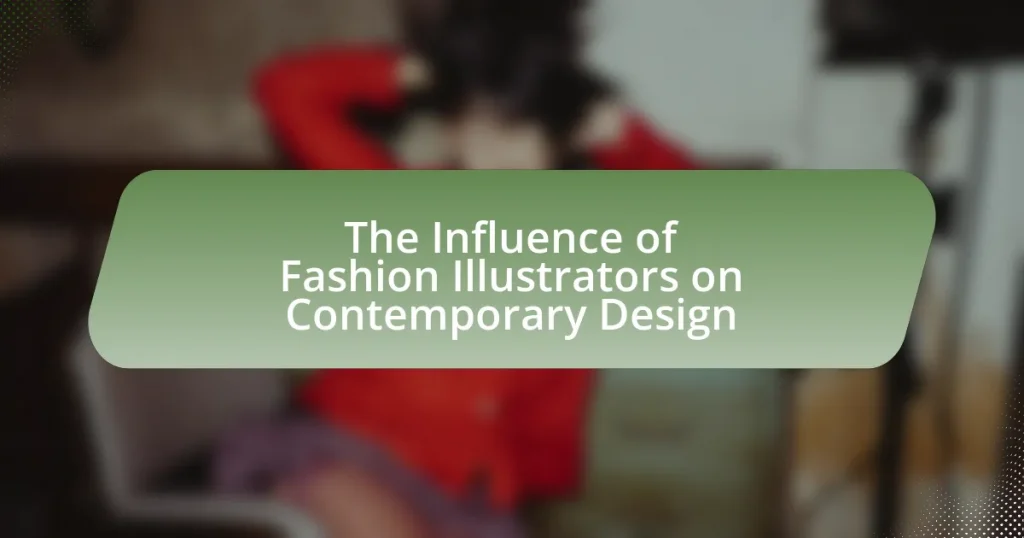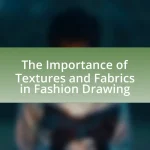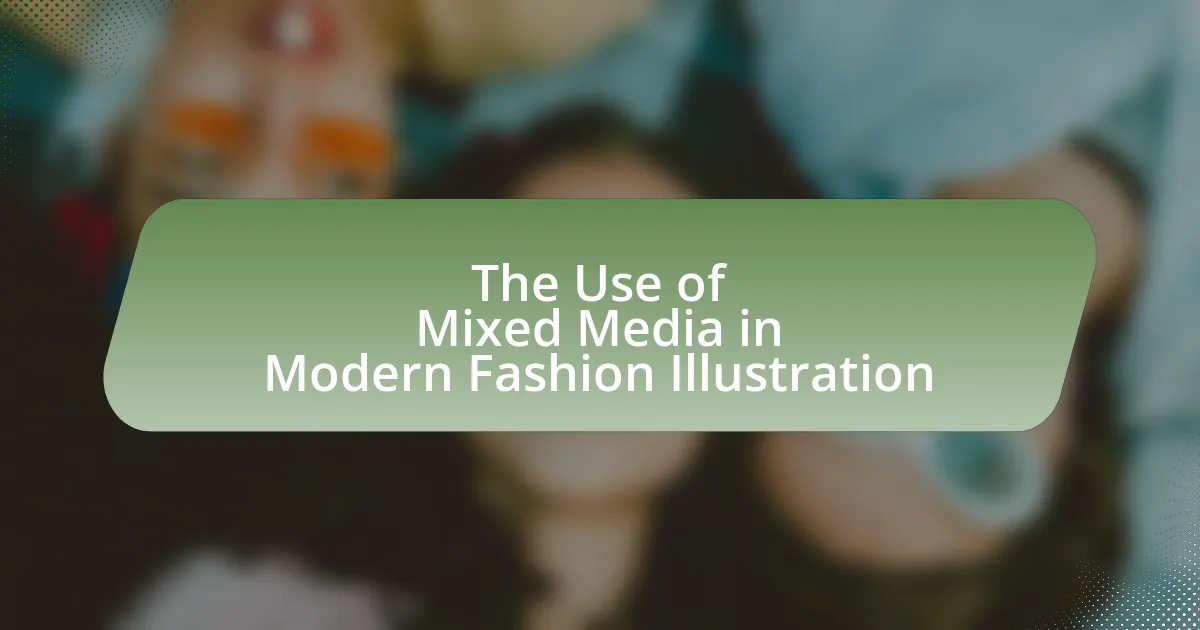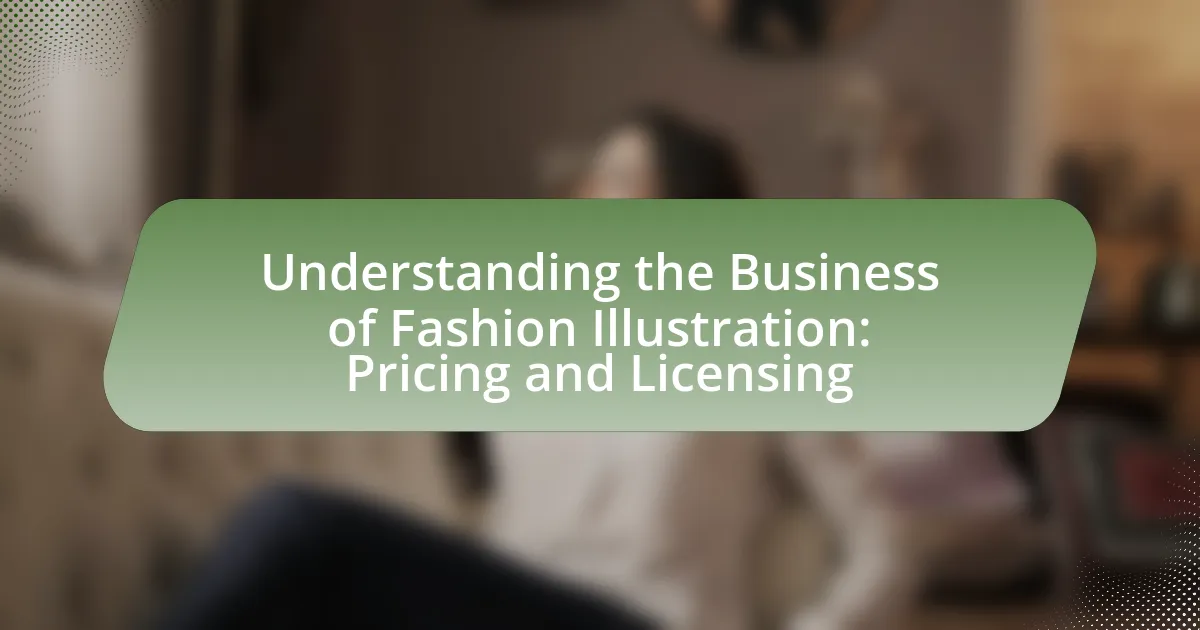The article examines the significant influence of fashion illustrators on contemporary design, highlighting their role in shaping visual trends and inspiring designers through artistic interpretations. It discusses how illustrators like David Downton and Megan Hess have impacted modern design by translating complex fashion concepts into accessible visuals, fostering collaborations with brands, and enhancing creativity within the industry. The article also explores the historical context of fashion illustration, its relationship with cultural movements, and the ethical considerations surrounding representation and diversity. Additionally, it addresses the challenges faced by illustrators in adapting to market demands and technological advancements while providing insights into best practices for collaboration and brand building in the fashion industry.
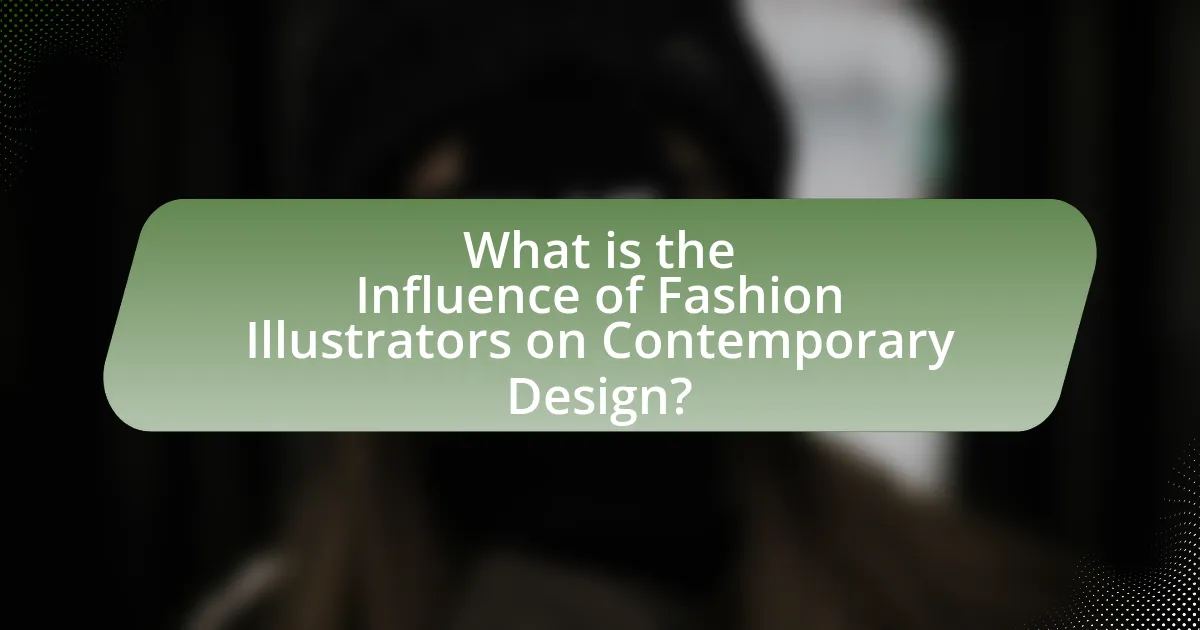
What is the Influence of Fashion Illustrators on Contemporary Design?
Fashion illustrators significantly influence contemporary design by shaping visual trends and inspiring designers through their unique artistic interpretations. Their work often serves as a bridge between fashion concepts and consumer perception, translating complex ideas into accessible visuals. For instance, iconic illustrators like David Downton and Megan Hess have impacted the industry by creating recognizable styles that resonate with both designers and the public, leading to collaborations and increased visibility for fashion brands. This symbiotic relationship enhances creativity and innovation in contemporary design, as illustrators provide fresh perspectives that challenge traditional aesthetics and encourage experimentation.
How have fashion illustrators shaped modern design trends?
Fashion illustrators have significantly shaped modern design trends by serving as visual communicators who translate designers’ concepts into compelling imagery. Their artwork not only captures the essence of garments but also influences consumer perceptions and trends through platforms like social media and fashion publications. For instance, the rise of digital illustration has allowed fashion illustrators to reach wider audiences, impacting trends in real-time, as seen with the popularity of specific styles showcased on Instagram. Additionally, iconic illustrators like David Downton and Megan Hess have established recognizable styles that resonate with contemporary aesthetics, further guiding the direction of fashion design. Their contributions have led to a fusion of art and fashion, making illustration a vital component in the evolution of modern design trends.
What historical context led to the rise of fashion illustration?
The rise of fashion illustration was primarily influenced by the development of print media and the fashion industry in the 19th century. As magazines and newspapers became more popular, they sought to visually represent the latest trends, leading to an increased demand for illustrations that showcased clothing designs. Notably, the establishment of publications like “Harper’s Bazaar” in 1867 and “Vogue” in 1892 provided platforms for illustrators to display their work, thus solidifying the role of fashion illustration in communicating style and trends. This historical context highlights the symbiotic relationship between print media and fashion, which propelled illustrators into prominence as key figures in the fashion narrative.
How do fashion illustrators interpret and influence cultural movements?
Fashion illustrators interpret and influence cultural movements by visually translating societal trends, values, and emotions into artistic representations. Their illustrations often reflect the zeitgeist, capturing the essence of cultural shifts such as feminism, sustainability, or technological advancement. For instance, during the 1960s, fashion illustrators like David Bailey depicted the youth culture and countercultural movements, which influenced mainstream fashion by promoting bold styles and breaking traditional norms. This interplay between illustration and culture not only shapes public perception but also inspires designers to create collections that resonate with contemporary societal themes, thereby reinforcing the connection between fashion and cultural identity.
Why are fashion illustrators considered vital in the design process?
Fashion illustrators are considered vital in the design process because they effectively communicate design concepts visually, bridging the gap between ideas and tangible products. Their illustrations serve as a crucial tool for designers to visualize and refine their creative visions, allowing for immediate feedback and adjustments. For instance, renowned fashion houses like Dior and Chanel have historically relied on illustrators to convey their collections before production, ensuring that the final garments align with the intended aesthetic. This collaborative process enhances creativity and efficiency, ultimately leading to more innovative and market-ready designs.
What role do they play in the communication of fashion concepts?
Fashion illustrators play a crucial role in the communication of fashion concepts by visually translating designers’ ideas into compelling imagery. Their illustrations serve as a bridge between the abstract concepts of fashion design and the tangible products that consumers ultimately see and purchase. For instance, fashion illustrations can capture the mood, texture, and movement of garments, providing a narrative that written descriptions alone cannot convey. This visual representation is essential in marketing and editorial contexts, where impactful imagery can influence consumer perception and trends. Historical evidence shows that iconic fashion illustrations, such as those by René Gruau in the mid-20th century, significantly shaped public understanding and appreciation of fashion, demonstrating the lasting impact of illustrators on the industry.
How do fashion illustrators collaborate with designers and brands?
Fashion illustrators collaborate with designers and brands by creating visual representations of concepts, collections, and marketing materials that align with the brand’s vision. This collaboration often involves initial discussions where designers share their ideas, themes, and inspirations, allowing illustrators to translate these into sketches or digital illustrations that capture the essence of the collection. For instance, renowned fashion illustrator David Downton has worked with brands like Valentino and Chanel, illustrating their collections and enhancing their visual storytelling. This partnership not only helps in refining design ideas but also plays a crucial role in promotional campaigns, as illustrated works can be used in lookbooks, advertisements, and social media, thereby amplifying the brand’s reach and aesthetic appeal.
What are the key characteristics of contemporary fashion illustration?
Contemporary fashion illustration is characterized by a blend of realism and abstraction, vibrant color palettes, and diverse styles that reflect cultural influences. This duality allows illustrators to convey both the essence of fashion and the emotional narrative behind it. The use of digital tools has also become prevalent, enabling artists to experiment with textures and effects that enhance visual storytelling. Additionally, contemporary fashion illustration often emphasizes inclusivity, showcasing a range of body types, ethnicities, and gender expressions, which aligns with the evolving landscape of the fashion industry. This shift is supported by the increasing demand for representation in visual media, making contemporary fashion illustration a vital component of modern design discourse.
How has technology impacted the style and technique of fashion illustration?
Technology has significantly transformed the style and technique of fashion illustration by introducing digital tools that enhance creativity and efficiency. Digital illustration software, such as Adobe Illustrator and Procreate, allows artists to create intricate designs with precision and ease, enabling them to experiment with colors, textures, and styles that were previously difficult to achieve with traditional methods. Furthermore, the rise of social media platforms has expanded the reach of fashion illustrators, allowing them to showcase their work to a global audience and collaborate with designers in real-time. This shift has led to a more diverse range of styles and techniques, as illustrators can draw inspiration from various cultures and trends instantly. The integration of technology in fashion illustration not only streamlines the creative process but also democratizes the field, making it accessible to a wider range of artists.
What are the different mediums used by fashion illustrators today?
Fashion illustrators today utilize a variety of mediums, including traditional methods like pencil, ink, and watercolor, as well as digital tools such as Adobe Illustrator and Procreate. Traditional mediums allow for unique textures and styles, while digital platforms provide versatility and ease of editing. The integration of both approaches enables illustrators to create diverse and innovative designs that resonate with contemporary fashion trends.
How does the influence of fashion illustrators manifest in various design fields?
The influence of fashion illustrators manifests in various design fields through their ability to shape visual narratives and trends, impacting areas such as textile design, product development, and advertising. Fashion illustrators provide a unique perspective that combines artistic expression with market insights, allowing designers to visualize concepts and communicate ideas effectively. For instance, the work of illustrators like David Downton has been pivotal in influencing haute couture collections, as their illustrations often serve as a bridge between initial design concepts and final garments. Additionally, fashion illustrations are frequently utilized in marketing campaigns, where they help convey brand identity and aesthetic, as seen in the campaigns of luxury brands like Chanel and Dior, which often feature illustrated elements to evoke a specific lifestyle.
What are the emerging trends in fashion illustration and design?
Emerging trends in fashion illustration and design include the integration of digital technology, sustainability, and inclusivity. Digital platforms enable illustrators to create and share their work more widely, utilizing tools like augmented reality and 3D modeling to enhance visual storytelling. Sustainability is increasingly prioritized, with designers focusing on eco-friendly materials and practices, reflecting consumer demand for ethical fashion. Inclusivity is also a significant trend, as fashion illustrations now often represent diverse body types, ethnicities, and gender identities, aligning with broader societal movements for representation. These trends are reshaping the landscape of fashion illustration and design, making it more accessible and relevant to contemporary audiences.
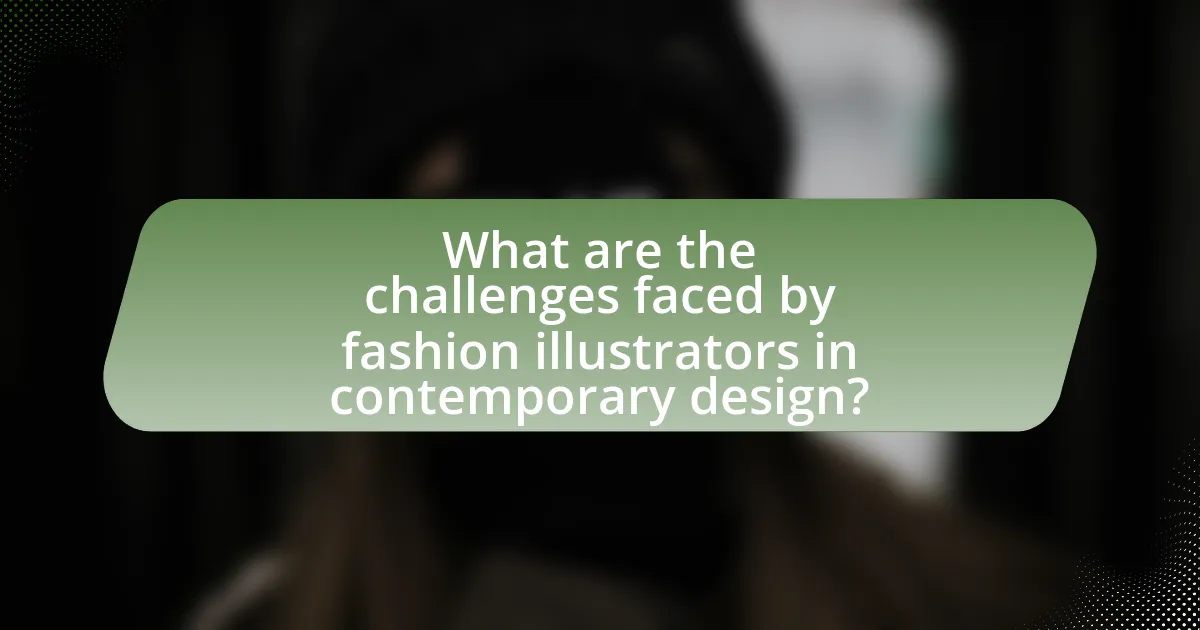
What are the challenges faced by fashion illustrators in contemporary design?
Fashion illustrators in contemporary design face several challenges, including the rapid evolution of technology, the need for versatility in styles, and competition from digital media. The rise of digital platforms has shifted the focus towards digital illustration, requiring traditional illustrators to adapt their skills to new tools and software. Additionally, fashion illustrators must be versatile, as clients often demand a range of styles to appeal to diverse audiences. Competition from digital content creators, such as social media influencers and graphic designers, further complicates the landscape, making it essential for illustrators to differentiate their work and maintain relevance in a saturated market.
How do market demands affect the work of fashion illustrators?
Market demands significantly influence the work of fashion illustrators by dictating the styles, themes, and techniques they employ. As consumer preferences shift towards sustainability and inclusivity, illustrators adapt their artwork to reflect these trends, ensuring relevance in a competitive market. For instance, a report by McKinsey & Company highlights that 67% of consumers consider sustainability when making fashion purchases, prompting illustrators to incorporate eco-friendly themes in their designs. This responsiveness to market demands not only shapes the visual language of fashion but also impacts the commercial viability of the illustrations produced.
What pressures do illustrators face in maintaining their artistic integrity?
Illustrators face significant pressures in maintaining their artistic integrity, primarily due to commercial demands and client expectations. These pressures often compel illustrators to compromise their unique styles or creative visions to align with market trends or specific client requests. For instance, a study by the American Institute of Graphic Arts (AIGA) highlights that 70% of illustrators report feeling the need to adapt their work to meet client specifications, which can dilute their personal artistic expression. Additionally, the competitive nature of the industry further exacerbates these pressures, as illustrators may feel compelled to conform to popular aesthetics to secure work, thereby risking their individual artistic identity.
How do fashion illustrators adapt to changing consumer preferences?
Fashion illustrators adapt to changing consumer preferences by incorporating current trends and cultural influences into their artwork. They analyze market data and consumer behavior to understand what styles resonate with audiences, allowing them to create illustrations that reflect contemporary tastes. For instance, the rise of sustainability in fashion has led illustrators to depict eco-friendly materials and practices, aligning their work with consumer values. Additionally, fashion illustrators often engage with social media platforms to gauge real-time feedback and trends, ensuring their illustrations remain relevant and appealing to the target demographic. This responsiveness to consumer preferences is crucial for maintaining their influence in the fashion industry.
What ethical considerations are involved in fashion illustration?
Ethical considerations in fashion illustration include issues of representation, cultural appropriation, and the impact of body image. Fashion illustrators have a responsibility to portray diverse body types and ethnicities accurately, as misrepresentation can perpetuate stereotypes and contribute to societal beauty standards. Cultural appropriation arises when illustrators use elements from marginalized cultures without understanding or respecting their significance, which can lead to exploitation. Additionally, the promotion of unrealistic body images through illustration can negatively affect mental health, particularly among young audiences. These considerations highlight the need for ethical awareness and sensitivity in the practice of fashion illustration.
How do issues of representation and diversity impact fashion illustration?
Issues of representation and diversity significantly impact fashion illustration by shaping the narratives and aesthetics presented in the industry. When fashion illustrators include diverse body types, ethnicities, and gender identities, they challenge traditional beauty standards and broaden the scope of what is considered fashionable. For instance, a study by the Fashion Institute of Technology found that diverse representation in fashion media leads to increased consumer engagement and brand loyalty, as consumers feel more connected to brands that reflect their identities. This shift not only influences the visual language of fashion but also drives inclusivity in design practices, ultimately fostering a more equitable industry.
What responsibilities do fashion illustrators have towards their audience?
Fashion illustrators have the responsibility to accurately represent fashion trends and communicate artistic vision to their audience. This involves creating illustrations that reflect current styles, cultural contexts, and the intended message of fashion designers. By doing so, fashion illustrators help inform and inspire their audience, enabling them to understand and engage with contemporary fashion. Accurate representation is crucial, as it influences public perception and can shape consumer behavior, making it essential for illustrators to maintain integrity and authenticity in their work.
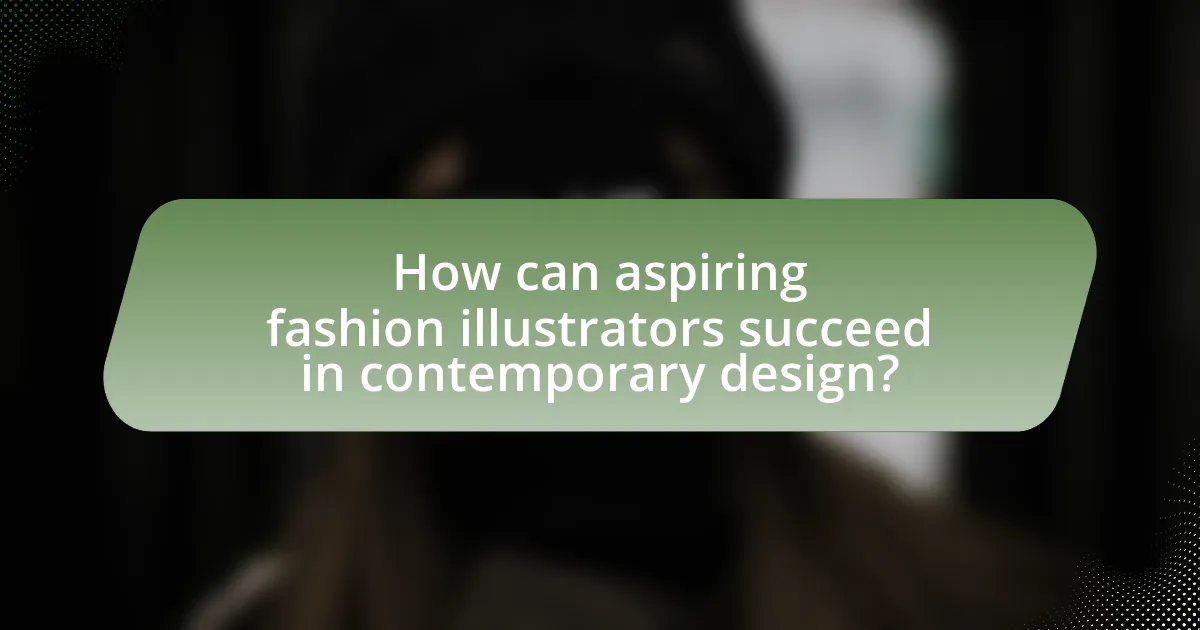
How can aspiring fashion illustrators succeed in contemporary design?
Aspiring fashion illustrators can succeed in contemporary design by developing a unique artistic style that resonates with current trends and effectively communicates fashion concepts. This involves continuous practice, studying contemporary designers, and understanding the market demands. For instance, successful illustrators often leverage social media platforms to showcase their work, engage with audiences, and network with industry professionals, which can lead to collaborations and job opportunities. According to a survey by the Fashion Institute of Technology, 70% of fashion illustrators reported that social media significantly boosted their visibility and career prospects.
What skills are essential for a successful career in fashion illustration?
Essential skills for a successful career in fashion illustration include strong drawing abilities, a deep understanding of fashion design, and proficiency in digital illustration tools. Strong drawing skills enable illustrators to accurately depict garments and styles, while knowledge of fashion design principles helps them create relevant and appealing illustrations. Proficiency in digital tools, such as Adobe Illustrator and Photoshop, is crucial as the industry increasingly relies on digital formats for presentations and marketing. These skills collectively enhance an illustrator’s ability to communicate fashion concepts effectively, making them valuable in the contemporary design landscape.
How can one develop a unique style as a fashion illustrator?
To develop a unique style as a fashion illustrator, one should focus on personal expression through consistent practice and experimentation with various techniques. Engaging in diverse artistic styles, such as studying different art movements or incorporating mixed media, allows illustrators to discover what resonates with their vision. Additionally, analyzing the work of established fashion illustrators can provide inspiration while encouraging the development of an individual aesthetic. Research indicates that artists who regularly create and refine their work are more likely to establish a distinctive style, as seen in the careers of notable illustrators like David Downton and Megan Hess, who have successfully blended personal flair with fashion trends.
What resources are available for learning and improving illustration techniques?
Resources for learning and improving illustration techniques include online platforms, books, and workshops. Websites like Skillshare and Udemy offer courses specifically focused on illustration, covering various styles and techniques. Books such as “Drawing on the Right Side of the Brain” by Betty Edwards provide foundational skills and insights into the artistic process. Additionally, attending workshops or classes at local art schools or community centers allows for hands-on experience and direct feedback from instructors. These resources collectively enhance skills and knowledge in illustration, making them effective for both beginners and advanced artists.
What strategies can fashion illustrators use to build their brand?
Fashion illustrators can build their brand by leveraging social media platforms, creating a distinctive style, and collaborating with fashion brands. Social media, particularly Instagram and Pinterest, allows illustrators to showcase their work to a global audience, increasing visibility and engagement. A distinctive style helps in establishing a unique identity, making the illustrator recognizable in a crowded market. Collaborating with fashion brands not only provides exposure but also enhances credibility, as partnerships with established names can attract a wider audience. These strategies are supported by the fact that over 70% of fashion brands utilize social media for marketing, highlighting its importance in brand building.
How important is social media presence for fashion illustrators?
Social media presence is crucial for fashion illustrators as it significantly enhances their visibility and marketability. A strong social media presence allows illustrators to showcase their work to a global audience, connect with potential clients, and engage with followers, which can lead to increased opportunities in the fashion industry. According to a survey by the Creative Industries Federation, 70% of creative professionals reported that social media has positively impacted their career, highlighting its importance in building a personal brand and networking within the industry.
What networking opportunities should illustrators pursue in the industry?
Illustrators should pursue networking opportunities such as attending industry conferences, participating in art fairs, joining professional organizations, and engaging in online communities. These platforms allow illustrators to connect with peers, potential clients, and industry leaders, enhancing their visibility and career prospects. For instance, events like the Society of Illustrators’ annual exhibition provide direct access to influential figures in the field, while online platforms like Behance and Instagram facilitate global networking and collaboration. Engaging in these opportunities can lead to valuable partnerships and increased exposure in the competitive landscape of fashion illustration.
What are the best practices for collaborating with fashion designers?
The best practices for collaborating with fashion designers include establishing clear communication, understanding the designer’s vision, and providing constructive feedback. Clear communication ensures that both parties are aligned on goals and expectations, which is crucial for a successful partnership. Understanding the designer’s vision allows collaborators to contribute effectively while respecting the creative direction. Providing constructive feedback fosters a positive working environment and enhances the final product. These practices are supported by industry standards that emphasize collaboration as a key factor in successful fashion projects, highlighting the importance of teamwork in achieving innovative designs.
How can effective communication enhance collaboration outcomes?
Effective communication enhances collaboration outcomes by ensuring clarity, alignment, and mutual understanding among team members. When individuals share information effectively, they reduce misunderstandings and foster a collaborative environment where ideas can be exchanged freely. Research indicates that teams with strong communication practices are 25% more productive, as they can coordinate efforts and leverage diverse perspectives more efficiently. This increased productivity directly contributes to better project outcomes and innovation in design, particularly in fields like fashion illustration, where collaboration is essential for creative success.
What common pitfalls should illustrators avoid in partnerships?
Illustrators should avoid lack of clear communication in partnerships, as it can lead to misunderstandings and unmet expectations. Effective communication ensures that all parties are aligned on project goals, deadlines, and creative direction. Additionally, illustrators must steer clear of neglecting contracts, which can result in disputes over rights, compensation, and responsibilities. Establishing a written agreement protects both parties and clarifies terms. Another pitfall is failing to respect each other’s creative input, which can stifle collaboration and innovation. Valuing diverse perspectives fosters a more productive partnership. Lastly, illustrators should avoid overcommitting to multiple projects simultaneously, as this can compromise the quality of their work and strain relationships. Balancing workload is essential for maintaining professional integrity and partnership success.
